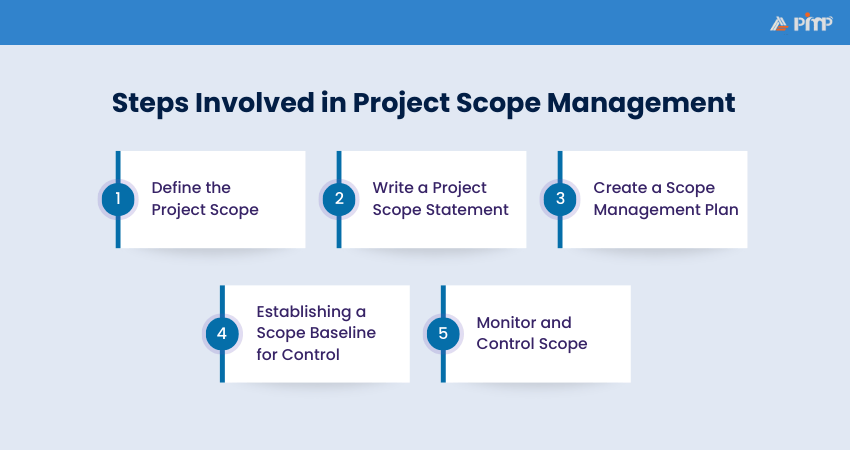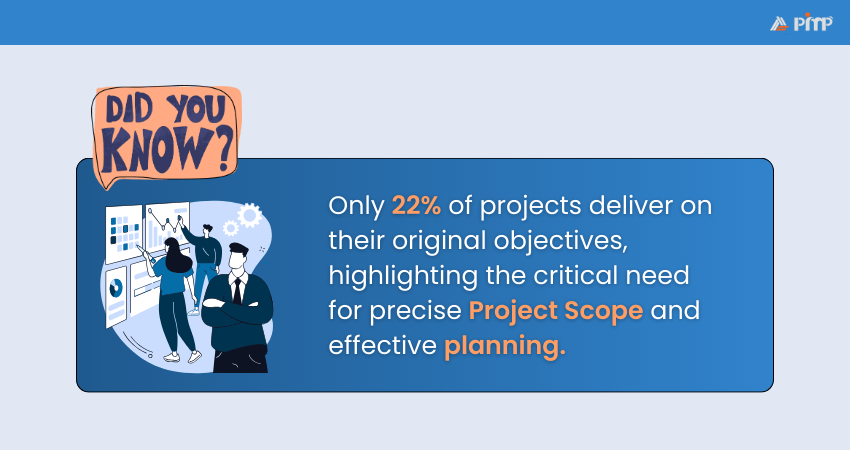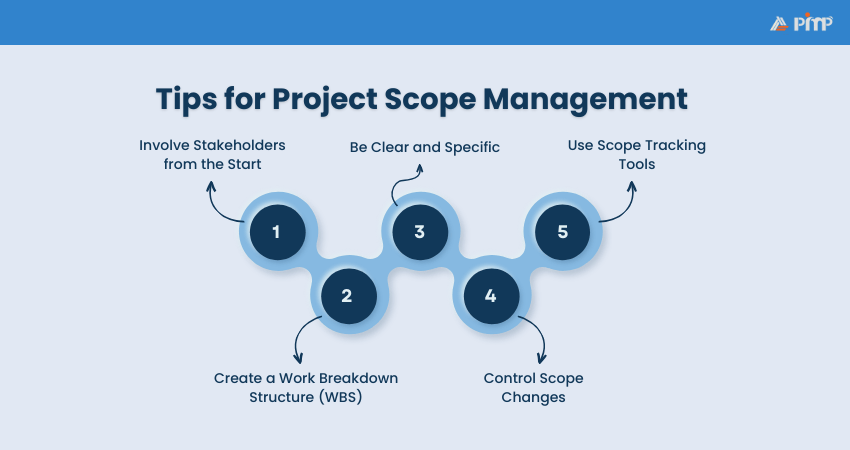







 10 Sep 2024
10 Sep 2024



But I thought that feature was included!’ Does this sound familiar? That’s a classic scope issue. It is the kind of confusion that causes frustration between clients and teams, even when everyone has the best intentions.
When the scope is vague or poorly communicated, teams take on unplanned work, require extra hours, and exceed costs, all because expectations weren’t aligned. No one wins. But there is a solution, and that is the Scope in Project Management. With a clear, agreed scope, everyone knows exactly what to expect. Keep reading to learn how to define project scope and manage it smartly!
Table of Contents
1) What is Scope in Project Management?
2) Why Project Management Scope is Important?
3) Project Scope Management Steps
4) Benefits of Defining Project Scope Early
5) Project Scope Example
6) Five Tips for Project Scope Management
7) Conclusion
Scope is one of the core pillars of Project Management. It defines exactly what the project is expected to deliver, including its boundaries, tasks, deliverables, and constraints. In simple terms, scope sets clear limits on what is part of the project and what is excluded.
This Scope acts as a shared agreement between stakeholders, project teams, and clients. It helps avoid misunderstandings, controls project changes, and keeps everyone focused on the intended outcomes.
Defining Project Management Scope is essential for aligning teams, managing expectations, and delivering successful outcomes. Without it, projects risk delays, budget overruns, and missed goals. Here’s why it is so important:
1) Keeps Everyone Aligned: The Scope provides a shared reference for teams and stakeholders, reducing confusion.
2) Outlines Constraints: By identifying the limits early, you can manage risks and avoid disruptions.
3) Clarifies Success Metrics: It defines what outcomes (like cost or conversion rate) will be measured.
4) Manages Stakeholder Expectations: Everyone agrees on what has been included and what hasn’t been in your project.
5) Supports Planning: A defined scope improves budgeting, resource allocation, and scheduling.
6) Encourages Compromise: It enables discussions to balance priorities and capacity.
7) Prevents Scope Creep: When you set clear boundaries, it helps reduce unplanned changes and distractions.
Scope in Project Management isn’t a one-time task. Instead, it is a process with key steps to ensure control and clarity throughout the project lifecycle. Here are the five key steps in effective Project Scope Management:

This is the starting point of the Project Scope Management process. It involves identifying the project's stakeholders and collecting their requirements. During this step, ideas from different domains are considered to define the overall purpose, goals, boundaries, and expectations of the project. Key actions involve:
1) Identify all stakeholders and their roles
2) Know what is needed through meetings or surveys
3) Determine project goals, boundaries, and deliverables
4) Create an initial outline of the scope
Once the scope is defined, it is documented in a Project Scope Statement. The statement acts as a detailed reference for the entire team, helping everyone understand what needs to be achieved and by when. In Agile or traditional environments, this is critical for clarity and alignment on project deliverables. It includes:
1) Project objectives and deliverables
2) Inclusions and exclusions
3) Constraints and assumptions
4) Key milestones and Scope baseline
Gain the skills and mindset to manage projects effectively with our PMI Project Management Ready® Certification – Register today!
The Scope Management plan outlines how the Scope will be monitored and controlled throughout the project lifecycle. This plan ensures that the Project Scope remains aligned with the project’s goals, even when unforeseen changes arise. It also sets clear steps for evaluating and approving Scope adjustments. It includes:
1) Processes for scope definition and change control
2) Roles and responsibilities for managing scope
3) Procedures for handling scope-related updates
4) Tools or systems used for scope tracking
The Scope Baseline is the approved version of the project scope. Once approved, this baseline becomes the reference point for monitoring all work. It helps control deviations by ensuring that all activities are tracked and evaluated against clearly defined expectations. It is used to assess and approve necessary corrections. This involves:
1) The finalized Project Scope Statement
2) The Work Breakdown Structure (WBS)
3) The WBS Dictionary
4) Approved change requests that impact the Scope
Throughout the project lifecycle, it is essential to continuously track progress against the scope baseline. If any kind of unrealistic expectations arise or deliverables expand beyond the original plan, the Change Control Process helps manage adjustments in a controlled way. This step consists of:
1) Verifying that completed work meets the Scope requirements
2) Managing and documenting change requests
3) Preventing Scope creep
4) Using tools like change control processes or Gantt charts
Establishing the scope at the beginning of a project brings multiple benefits. Let's check what those benefits are:

1) Expectation Management: When the Scope is clearly outlined, it becomes easier to get stakeholder buy-in and reduce the chance of disputes or last-minute changes.
2) Prevention of Scope Creep: With defined boundaries, you can identify when requests go beyond the original plan and address them properly.
3) Structured Change Control: For complex projects, a clear scope sets the stage for managing change requests in a controlled, documented way.
4) Goal Alignment: Scope helps ensure that every task contributes directly to the project’s main objectives.
5) Drives Accountability: When stakeholders help define the scope, they are more likely to support and respect it.
6) Facilitates Smoother Approvals: Regular input leads to faster sign-offs and fewer disputes.
7) Minimizes Rework: Early agreement reduces the chances of late-stage changes that cause delays.
Show your leadership in managing uncertainty with our PMI-RMP® Certification – Sign up anytime!
Let’s consider that a company is developing a new e-commerce website. Here's what a simplified project scope might include:
Objectives:
1) Build a responsive website for online retail
2) Integrate payment gateways
3) Launch by Q2 (second quarter of the calendar year)
4) Increase website traffic by 20%
5) Improve user engagement by 15%
Deliverables:
1) Homepage, product pages, cart and checkout
2) User login and account features
3) Mobile-optimized design
4) Admin dashboard
Out of Scope:
1) Inventory Management System
2) Social media campaign
Constraints:
1) £50,000 budget
2) Must comply with GDPR
Assumptions:
1) Product descriptions and images will be provided by the client
2) Hosting will be managed externally
This level of detail ensures that the client, designers, developers, and marketing teams are all on the same page.
Now, let's check what the five practical tips are to help manage your Project Scope successfully:

1) Involve Stakeholders from the Start:
Get feedback and ideas from clients, team members, and decision-makers early. This helps avoid missed expectations later.
2) Create a Work Breakdown Structure (WBS):
Break down the scope into smaller, manageable tasks to improve planning, tracking, and team clarity.
3) Be Clear and Specific:
Avoid vague language in your scope. Clearly define deliverables, exclusions, and constraints to reduce confusion.
4) Control Scope Changes:
Stick to the approved scope and use a formal change control process to neglect any scope creep.
5) Use Scope Tracking Tools:
Use project tools like Trello, Jira, or Microsoft Project to stay on top of tasks, monitor progress, and manage change requests easily.
The Scope in Project Management is more than just a planning step. It is the foundation of every project's success. When clearly defined and well-managed, scope helps align teams, manage stakeholder expectations, and keep projects on track from start to finish. It is your blueprint for success that needs to be implemented.
Drive smarter project decisions and analysis into action with our PMI-PBA® Certification – Join immediately!






© Copyright 2025. All rights reserved. Contact: PMP® TRAINING ACADEMY.


